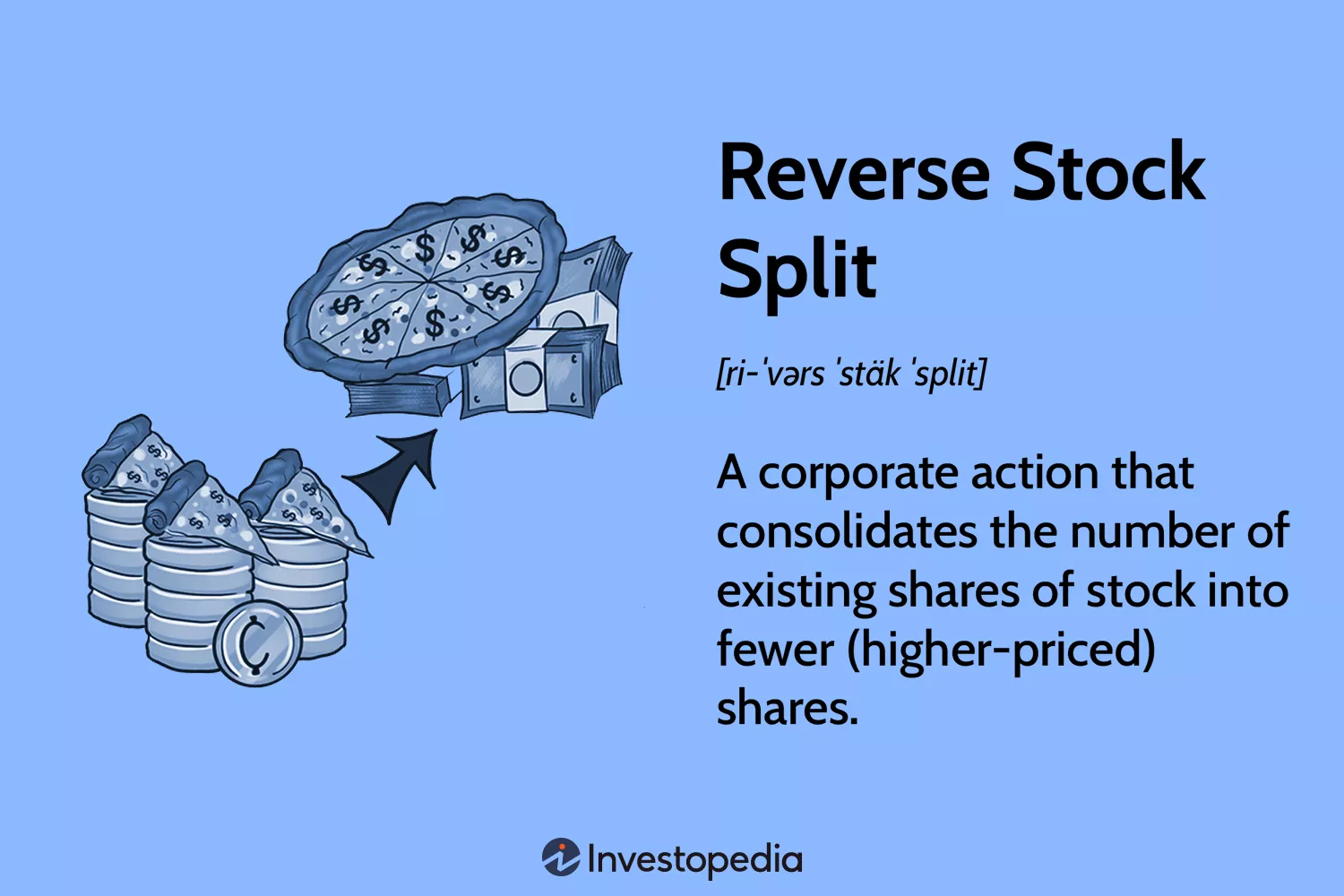什么是反向股票分割?
反向股票分割是一种公司行为,It combines an existing number of shares into fewer (higher priced) shares。A reverse stock split divides the total number of existing shares by a number like 5 or 10,Respectively called 1:5 or 1:10 reverse split。Reverse stock split also known as stock merger、Stock consolidation or stock rollback,Opposite of stock split,A stock split is the dividing of one stock into multiple parts。
Main points
- 反向股票分割将股东持有的现有股票数量合并为更少的股票。
- A reverse stock split does not directly affect a company's value (only its stock price)。
- It can indicate that a company is in trouble,Because it increases the value of low-priced stocks。
- Staying relevant and avoiding delisting are the most common reasons companies adopt this strategy。

投资百科/瑞安·奥克利
了解反向股票分割
根据市场发展和情况,A company can take a number of actions at the corporate level that may affect its capital structure。One of them is a reverse stock split,i.e. existing company stock is effectively merged,to create a smaller number of shares that are proportionally more valuable。Since the company will not create any value by reducing the number of shares,Therefore the price per share will rise proportionally。
Increased price per share is the primary reason companies choose reverse stock splits,The relevant ratio may vary from 1:2 to Gundam 1:100 No wait。A reverse stock split won't affect a company's value,Although they are usually the result of a significant depreciation in the value of their shares。The negative connotations associated with this behavior are often self-defeating,Because stocks will come under renewed selling pressure。
Reverse stock split proposed by company management,and must be approved by shareholders through voting rights。
反向股票分割的优点和缺点
公司决定减少市场上已发行股票数量的原因 有多种,some of them are beneficial。
优点
防止重大交易所下架:Shares may have hit all-time lows,This could leave it vulnerable to further market pressures and other adverse developments,For example, failure to meet exchange listing requirements。
Exchanges usually set minimum purchase prices for listed stocks.。If the stock falls below the purchase price,and remain below that threshold level for a period of time,There is a risk of being delisted from the exchange。
For example,Nasdaq could sustain a lower share price per share 1 USD stocks delisted。1After being removed from national exchanges,The company's stock will be downgraded to penny stock status,Forcing them to be listed on the Pink Sheet。Once you enter the alternative market for these low value stocks,These stocks will become more difficult to buy and sell。
attract big investors:The company also maintains a higher share price through reverse stock splits,Because many institutional investors and mutual funds have policies prohibiting holding stocks priced below minimum value。Even if a company is still not at risk of being delisted from an exchange,But if you don’t qualify for such a large investor to buy,would damage its trading liquidity and reputation.。
Meet regulatory agency requirements:in different jurisdictions around the world,The regulation of a company depends on factors such as the number of shareholders。By reducing the number of shares,Companies sometimes aim to reduce the number of shareholders,subject it to its preferred regulator or preferred law。Companies that want to go private may also try to reduce the number of shareholders through such measures。
Raise the breakup price: Plans to create and list spin-off companies,An independent company established by selling or allocating new shares of an existing business or division of a parent company,Reverse splits can also be used to obtain attractive prices。
For example,If the stock of the company planning to spin off is trading at a lower price,then the company may have difficulty pricing the shares of its spinoff company at a higher price。This problem can be solved by reverse splitting the stock and increasing the trading price per share。
缺点
Generally speaking,Market participants do not view reverse stock splits positively。This indicates that the stock price has bottomed,Company management attempts to artificially inflate stock price without any real business proposition。also,As the number of shares on the public market decreases,Liquidity of stocks may also be affected。
反向股票分割的示例
假设一家制药公司在市场上拥有 1000 10,000 outstanding shares,The trading price per share is 5 Dollar。Because the stock price is low,Company management may wish to artificially inflate the price per share。
it decided to proceed 1:5 reverse stock split,This essentially means that 5 Consolidation of existing shares into one new share。After corporate action,公司将拥有 200 万股新股(1000 万股 / 5),每股价格现在为 25 美元(5 美元 x 5)。
股价的相应变化也证明了公司并没有仅仅通过反向股票分割创造任何实际价值。公司行动前后 以市值为代表的整体价值应保持不变。
之前的市值是之前的总股数乘以之前的每股价格,Right now 5000 万美元(5 美元 x 1000 万美元)。股票合并后的市值等于新的总股数乘以新的每股价格,Right now 5000 万美元(25 美元 x 200 万美元)。
公司管理层决定进行反向股票分割的因素成为市场自动调整股价的倍数。
现实世界的例子
2002Year,美国最大的电信公司AT&T Inc.(T)进行了1比5的反向股票分割,同时计划剥离其有线电视部门并将其与康卡斯特公司(CMCSA)合并。 。计划采取公司行动是因为 AT&T 担心分拆可能导致其股价大幅下跌,并可能影响流动性、业务及其筹集资金的能力。2
反向股票分割的其他常见例子包括许多从事研发(R&D)的 小型且通常不盈利的公司,这些公司没有任何盈利或可销售的产品或服务。in this case,公司采取这种公司行动只是为了维持其在主要证券交易所的上市地位。
为什么公司要进行反向股票分割?
反向分割通常是在股价跌得太低时进行,从而使其面临因未满足某些最低价格要求而从交易所退市的风险。较高的股价还可以吸引某些不会考虑将细价股纳入其投资组合的投资者。
如果我拥有进行反向股票分割的股票会发生什么?
通过反向分割,记录在案的股东将看到他们拥有的股份数量减少,但也会看到每股价格以可比较的方式上涨。For example,在 1:10 的反向股票分割中,如果您在分割前拥有 1,000 股,交易价格为 5 Dollar,那么您将拥有 100 股,per share 50 Dollar。您的经纪人会自动处理此问题,因此您无需执行任何操作。反向分割不会影响您的税收。3
反向分割是好是坏?
很多时候,反向分割被视为负面的,因为它们表明公司的股价已大幅下跌,可能使其面临退市的风险。分拆后价格较高的股票对于某些更喜欢标价较低股票的散户投资者来说也可能缺乏吸引力。
为什么我持有的ETN有这么多反向分裂?
一些交易所交易产品,如交易所交易票据(ETN),其价值会随着时间的推移而自然衰减,并且必须定期进行反向分割,但这些产品的持有时间不会超过几个小时或几天。这是因为 ETN 从技术上讲是债务工具,持有商品或波动性相关工具等产品的衍生品,而不是实际的基础资产。
Summarize
当上市公司合并股票时,这称为反向股票分割,有时也称为股票合并、Stock consolidation or stock rollback。合并对公司的价值没有影响。For example,如果 500 万股的交易价格为每股 10 Dollar,则 1 比 5 的反向分割将导致 100 万股的交易价格为每股 50 Dollar。反向股票分割通常被视为负面的,因为它通常是一种抬高股票价格而不增加公司价值的手段。

